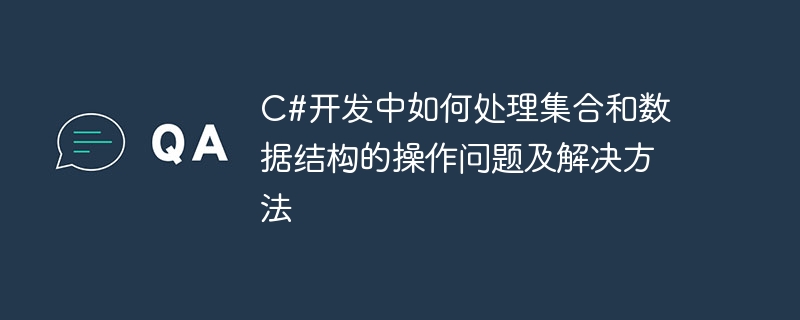

C# How to deal with the operation problems and solutions of collections and data structures in development
Introduction:
In C# development, collections and data structures are very important the concept of. They can help us organize and manage data and improve the efficiency and maintainability of programs. However, for beginners, you may encounter some problems with operating collections and data structures. This article describes some common problems and provides solutions and corresponding code examples.
1. Question: How to add elements to the collection?
Solution:
In C#, we can use the List
List<int> numbers = new List<int>(); numbers.Add(10); numbers.Add(20);
In the above code, we create a collection of type List
2. Question: How to traverse all elements in the collection?
Solution:
In C#, we can use the foreach loop to iterate through all elements in the collection. Here is a sample code:
List<int> numbers = new List<int> { 10, 20, 30 };
foreach (int number in numbers)
{
Console.WriteLine(number);
}In the above code, we create a collection of List
3. Question: How to find the specified element in the collection?
Solution:
In C#, List
List<int> numbers = new List<int> { 10, 20, 30, 40 };
int target = 30;
int index = numbers.FindIndex(x => x == target);
Console.WriteLine($"找到元素 {target} 在集合中的索引为:{index}");In the above code, we call the FindIndex method and pass in a Lambda expression to find the index of the element that meets the criteria.
4. Question: How to sort a collection in a specific order?
Solution:
In C#, we can use the Sort() method to sort the collection. Here is a sample code:
List<int> numbers = new List<int> { 3, 4, 1, 2 };
numbers.Sort();
foreach (int number in numbers)
{
Console.WriteLine(number);
}In the above code, we use the Sort() method to sort a collection of type List
5. Question: How to use stacks and queues in C#?
Solution:
In C#, we can use the Stack
Stack<int> stack = new Stack<int>();
stack.Push(10);
stack.Push(20);
int topElement = stack.Pop();
Console.WriteLine($"栈顶元素是:{topElement}");
Queue<int> queue = new Queue<int>();
queue.Enqueue(30);
queue.Enqueue(40);
int frontElement = queue.Dequeue();
Console.WriteLine($"队首元素是:{frontElement}");In the above code, we use the Stack
Conclusion:
This article introduces some common problems and solutions to problems dealing with collection and data structure operations in C# development. Through the understanding and practice of these issues, we can better apply the collections and data structures provided in C# and improve the efficiency and maintainability of the program. I hope this article can help readers when they encounter similar problems in daily development.
The above is the detailed content of How to deal with the operation problems and solutions of collections and data structures in C# development. For more information, please follow other related articles on the PHP Chinese website!
 Merge cell fill sequence number
Merge cell fill sequence number
 What should I do if the Chinese restart setting of vscode does not take effect?
What should I do if the Chinese restart setting of vscode does not take effect?
 Configuration of python environment variables
Configuration of python environment variables
 How to use sort function
How to use sort function
 Else usage in Python loop structure
Else usage in Python loop structure
 How to install linux system
How to install linux system
 How to open python after it is installed
How to open python after it is installed
 Unknown error 3004 solution
Unknown error 3004 solution




